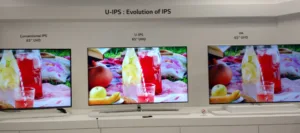LG Display had a meeting room and I was grateful to get a personal tour to what was being shown. Unfortunately, the marketing people I was with took the prohibition of photography very seriously, so I was much shorter on details than I might have been. However, Chris and Ken also went around and that helped fill in some gaps!
The tour started with a look at the latest OLEDs which are being used for TVs. As reported elsewhere, the peak brightness is increased and the previous demonstrations of very thin and flexible OLEDs have now become the new LG Electronics Wallpaper TV. The company was also talking about it’s Nano Cell technology, but we have covered that elsewhere. (LG: “We don’t need no stinking quantum dots.”)
One very cool innovation is what they call Crystal Sound OLED. This has been adopted in the Sony OLED TVs, but not one made by LG Electronics. Instead of conventional speakers, two special transducers are attached to the back of the ultra thin wallpaper display to create the audio. These actually vibrate the flexible OLED panel to produce sound waves. The benefit should be that voices should appear to emanate from the actors mouth, but the sound level and bass performance is going to be mediocre. We did get a demo in the room, but it was too noisy to really understand the sonic quality, but they had a nice visual with the TV placed horizontally and vibrating small particles under two glass domes. Crystal Sound is available on 55” and 65” wallpaper OLED panels.
We report separately on technology for audio from OLEDs, developed by Redux. Neither party mentioned the other, but we would be surprised if there was another company involved, given the patent position that Redux enjoys. (Redux Wants to Bring Display Surfaces to Life

LG Display also highlighted a number of additional commercial displays that have mostly been seen before. These included:
- Dual-sided 77” OLED display for digital signage applications. This is being used in some high end applications, but concerns about brightness and burn are limiting opportunities at the moment (that’s our view, not LG’s!)
- A 55” transparent OLED display- this remains several years away. Although there is a good looking sample with 45% transparency, the panel requires an RGB structure to achieve this level of transparency – LG’s current OLED architecture using an RGBW filter is not suitable,
- A 1×3 OLED video wall demo (plus the huge tunnel in the LG booth)
- Concave and convex OLED panels with a 980 mm curvature radius (800 cd/m² peak/99% DCI) There’s a picture of a pillar shown on the LG Electronics booth. (LG Has New Monitors and Projectors) The brightness drops from the peak level (10% of display) to 150 cd/m² (for 100%)
- 86” 58:9 and 88” 32:9 Art Pillar LCD displays (which were also shown by LGE on the show floor)
The company also highlighted its U-IPS architecture for LCD displays. This has a new pixel structure and features UV alignment to increase the luminance 10% on commercial panels (700 to 770 cd/m²). The design also uses transparent electrodes. (Historically, LGD has used copper electrodes because it can be driven better and was a pioneer on using copper. Staff in the room couldn’t tell us what material is being used). Transmittance is up from the previous generation S-IPS design from 5.38% to 5.99%, while the design has moved from a 3-sided borderless implementation to a 4-sided borderless one. It looks a little too bright in the comparison photo below.
There was an 8K 120Hz panel that uses a Gate-In-Panel architecture. The company told us that the U-IPS technology helps to getting to higher frame rates and resolutions.
Next we looked at a prototype panel for monitors for HDR grading that produces 1000 cd/m² and 1,300:1 contrast. The 31.5″ panel supports UltraHD and 98% of DCI-P3 and supports 10 bit data. (AUO has a panel that has a similar level of brightness and is being used for HDR gaming monitors, developed with Nvidia)
A 31.5″ 8k panel with 280ppi and using the ‘deep green’ technology that LGD has talked about for a while. This panel is a production unit that will go into mass production in March and is almost certainly the panel that is used in the Dell 8K monitor that was shown at the event. (Dell 8K Monitor Available Soon)
A 14″ panel for notebooks was shown that uses an oxide backplane and we also saw a 12.3″ 3:2 aspect ratio panel with around 293 ppi and 3000 x 2000 resolution. There was also a 31.5″ QuadHD IT panel and a 27″ UltraHD panel with borders of just 5.5mm.
An unusual display was being shown to try to get feedback from automotive companies. The display combined a 960 x 360 resolution front transparent OLED with an LCD on the back. This was very effective in showing depth.
The company also had touch and other displays including a 21.5″ display with 3840 x 720 resolution. Mirror displays are also an interesting application for LG and these were shown along with flexible OLEDs that could form shapes that are concave or convex.
Other displays in the room included:
- 13.3” In-Touch monitor with Active Pen. This uses in-cell touch which needs no extra cover glass and is for both IT and automotive applications.
- A 5.5-inch QHD plastic OLED – also in 5.7″ and with FullHD (we think we saw this in the Xiaomi Mi Note 2 – (CES 2017 Round-Up)
- Circular and square-type plastic OLED products for smartwatches with diagonals from 1.2″ to 1.53″.

